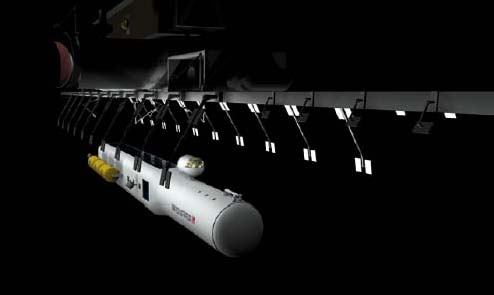|
Near-Term Manned Space Logistics Operations |
|||||||||||
 |
|||||||||||
| DISTRIBUTION A:
Approved for public release; distribution is unlimited. Document
created: 31 August 05
Air
& Space Power Journal ~ Chronicles
Online Journal ~ Article
Source |
|||||||||||
|
|
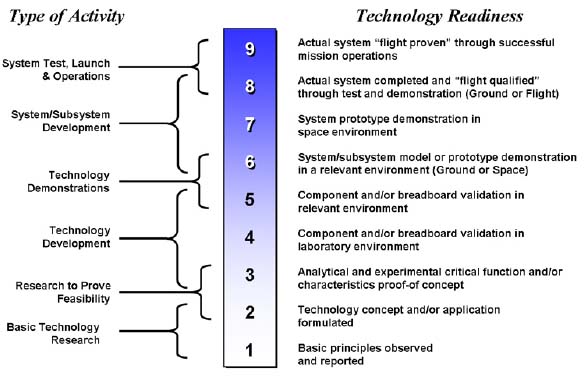 |
Figure 1. Definition of Technology Readiness Level and associated types of research, development, and operations activity used within the aerospace industry. |
Within the aerospace industry, the third best solution is determined through the use of the Technology Readiness Level (TRL) assessment of the prominent or enabling technologies in a proposed solution. Ranging from a minimum value of 1 for basic principles observed and reported to a maximum value of 9 for the actual system “flight proven through successful mission operations, see Fig. 1, it is generally accepted that when the enabling technologies reach a TRL of 6—system/subsystem model or prototype demonstration in a relevant environment (ground or space)—the technologies are sufficiently mature to support a decision to initiate system development. As the system advances through the design and production phases and begins operation, the enabling technologies advance in maturity through TRL 7 (system prototype demonstration in a space environment) and TRL 8 (actual system completed and “flight qualified” through test and demonstration) to TRL 9.
To select specific system configurations for development, the systems engineering team will usually emphasize solutions that minimize technology immaturity, as reflected by lower TRL values in the range of 6-8. The systems engineering function balances the added technical risk and time required to employ a TRL 6-8 enabling technology against the need for improved capabilities that cannot be achieved through the use of existing TRL 9 production technologies. Hence, a near-term concept is one that uses TRL 6-9 technologies effectively to enable the desired new capability to be developed and deployed without unacceptable cost or delay.
Identifying Near-Term Spacelift
Concepts Today’s Capabilities
Previous Air Force reusable spacelift interests
Interestingly, Secretary of Defense McNamara stated that a primary reason for canceling the Dyna-Soar program was that the system then under development was not capable of providing a space logistics capability for transporting passengers and cargo to and from an orbiting military space station. This rationale reflected a decision by the President and the Department of Defense, in 1963-64, to pursue the rapid development of a military Manned Orbiting Laboratory (MOL).12 The MOL program, announced in conjunction with the termination announcement of Dyna-Soar, was to be based on a version of the NASA two-person Gemini space capsule augmented with a pressurized laboratory compartment. No flight activities in the MOL program, other than an unmanned test flight of a Gemini capsule configured for the MOL use, were undertaken before the program ended in 1970.
Significant Air Force interest in reusable spacelift resurfaced a generation later, in the early 1980s, as a result of government and contractor vehicle conceptual design studies. The Air Force Systems Command’s (AFSC) Space Division initiated the Advanced Military Space Capability (AMSC) study in 1980. This was followed by the AFSC Aeronautical Systems Division (ASD) Transatmospheric Vehicle (TAV) study in 1983. Phase I of this study identified near-term TAV concepts while Phase II addressed military effectiveness and enabling technology readiness. By the time Phase II had begun in the summer of 1984:
The TAV program, focusing on rocket-powered concepts, did not proceed into development. Like the Dyna-Soar, it was impacted by changing national objectives. In this case, parallel feasibility studies—conducted on behalf of the Defense Advanced Research Projects Agency by the same ASD development planning office that was undertaking the TAV studies—of a reusable, horizontal takeoff and landing, scramjet-powered, single-stage Reusable Launch Vehicle (RLV) concept offered the prospect of a quantum leap in spacelift capabilities. Advocated by President Reagan in his 1986 State of the Union address, this study led to the National Aerospace Plane Program (NASP), also referred to as the X-30.14 Unfortunately, neither the X-30 nor the subsequent single-stage, rocket-powered X-33 programs successfully identified integrated vehicle solutions with sufficient performance to achieve orbit.TAV had grown into a major Air Force study effort, already characterized by overtones of growing into a major DoD-wide and even interagency study effort as well. ASD drew upon SAC (Strategic Air Command), TAC (Tactical Air Command), and Air Force Space Command in defining mission requirements and operational concepts, and representatives from HQ AFSC and organizations such as AFSC’s Space Division, Armament Division, Air Force Space Command, SAC, the Navy, and NASA had formed a general-officer-level steering group to evaluate the military potential of the TAV idea.13
Fully aware of the nation’s previous 40-year experience with reusable spacelift technology development, as well as the status of on-going technology research, the 2000 Air Force Scientific Advisory Board (SAB) study identified the most reasonable option for achieving near-term reusable spacelift solutions.
We envision that a TSTO [two-stage-to-orbit] launch system would lift substantial payload weight to LEO at a cost per pound of an order of magnitude or more lower than current or next-generation ELVs ($100 to $800 per pound depending on design and launch frequency). Such a system would be designed to be launched, recovered, and prepped for the next mission using procedures as much like current aircraft operations as possible, thereby providing affordable, reliable, responsive space launch to enable on-demand military space operations. Such a system would not only provide for affordable, reliable military space launch, but would also enable many more space and near-space missions (military, civil, and commercial) that today are made unaffordable by the high cost of access to space. Probably no other single technology offers such great promise of enabling the future of military space operations and civil space activities.15(Emphasis added)
Identifying Today’s RLV State-of-the-Art
To prepare for such RLV conceptual design studies, a joint government-industry partnership, called the Reusable Military Launch System Team, was organized. This team included the Air Force Research Laboratory (AFRL), Air Force Materiel Command’s Aeronautical System Center’s Engineering Directorate (ASC/EN), Air Force Flight Test Center, Air Force Space Command, NASA Kennedy and Johnson Space Centers, and industry. A primary product of this team’s efforts has been the development of a integrated set of parametric, geometry-based, RLV conceptual design computer tools. Developed under the leadership of ASC/EN and AFRL, these tools enable the preparation of conceptual design estimates of the size, weight, and performance of both near-term and other more advanced reusable spacelift concepts. ASC/EN and AFRL have used these tools to provide support for several recent Air Force studies, including one for Air Force Space Command.17
Estimates of Near-Term RLVs for Routine Spacelift
The TSTO RLV designs analyzed used a rocket-powered configuration incorporating vertical takeoff and horizontal landing. The system featured a stacked configuration with the second stage on top of the first stage. The airframe was modeled as traditional aluminum primary structure and propellant tanks with a thermal protection system of bonded-on ceramic tiles and blanket insulation. The second stage’s wing leading edges and nose cap were modeled as passively cooled structures. Critical subsystems—electrical power generation and distribution, avionics, propellant handling and distribution, on-orbit propulsion, etc.—were modeled using existing subsystem weights and performance. For propulsion, the first stage’s four engines were modeled as RD-180-equivalent liquid oxygen/kerosene engines (same thrust, specific impulse, and engine thrust-to-weight) while the second stage’s four engines were modeled as RD-120-equivalent engines with the addition of thrust-gimballing.18 Two second stage payload configurations were modeled; an internal payload bay for carrying cargo or passengers or an external configuration carrying a cargo module or a small passenger spaceplane (fig. 2).
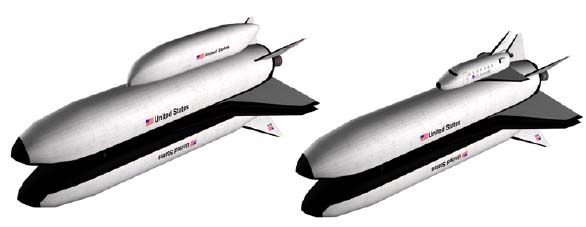 Figure 2. Generic two-stage, rocket-powered, 120 ft-long, reusable launch vehicle with external cargo module (left) and human transport spaceplane (right) representative of the type of system studied. Provided by John Livingston, Aeronautical Systems Center, Air Force Materiel Command. |
A good example of the process for selecting technologies with acceptable maturity relates to the choice of the ascent propulsion system for the first stage. Unlike jet engines, there is a very limited selection of rocket engines that would be suitable for a near-term RLV system development. The U.S. has not developed a high-thrust, reusable rocket engine since the Space Shuttle Main Engine was developed in the 1970s.19 As a result, alternative solutions, such as the RD-180, must be investigated if an achievable near-term, routine, reusable spacelift solution is to be identified.
The RD-180 is a twin-combustion chamber design, 860,000-lb thrust rocket engine developed in the late 1990s for the currently operating U.S. Atlas V ELV. It is a derivative of the four-combustion chamber RD-170 rocket engine. The RD-180 was designed and is today produced in Russia and provided for U.S. use through a U.S.-Russian industry partnership. Hence, the RD-180 represents a TRL 9 engine with known performance, weight, and installation requirements.
The RD-170—the production engine that the RD-180 is based on—was designed as a reusable engine for the Russian Buran Space Shuttle system. Today, it powers the first stage of the Russian Zenit ELV rocket used by the U.S.-led Sea Launch Corporation. One RD-170 test engine has achieved over 10 mission firings. Hence, the engine’s enabling technologies for reusability have been demonstrated to be at least TRL 6—system/subsystem model or prototype demonstration in a relevant environment (ground or space)—meaning that a version of the RD-180 may be suitable for use on a near-term RLV. Based on discussions with industry, a reasonable study assumption was that an equivalent U.S.-provided version of the RD-180 would be able to achieve 10 mission reuses by the time the RLV has reached the initial operational capability (IOC) status and 25 mission reuses by the time the RLV has achieved a full operational capability (FOC) status. Because the RD-120 represents the same fundamental engine technologies, it is also believed to be TRL 6 for reusable applications and appropriate for use on a near-term RLV’s second stage.
This degree of engine reusability represents a “third-best” solution suitable for a near-term RLV. At the current U.S. government flight rate of approximately twenty missions per year, a fleet of six operational RLVs (four in flight status and two in depot undergoing phase inspections) would require engine replacement about every two years at IOC and every five years at FOC. If the flight rate were to triple after the system achieved FOC, each system would fly about once every three weeks and the engine replacement interval would drop to about 18 months. This engine replacement would be done as part of a scheduled 25-flight “phase inspection” of the entire flight system.
To add additional conservatism to the design, the ASC/EN study incorporated three additional conservative elements. First, an empty weight margin of 15 percent was added to all non-primary propulsion weights. This empty weight margin reflects uncertainty with the detailed design of a specific configuration not reflected in the subsystem weight and performance estimating relationships used in the RLV models. Employing such a design margin is typical for conceptual design.
The second conservatism was the imposition of an engine-out requirement. The RLV would be capable of conducting the mission while incurring a safe shutdown of any of the four first or four second stage engines at any time following first stage engine ignition at launch. While this is not specifically related to adding conservatism to the weight and performance estimates, it makes the design more “aircraft-like” in the same manner that a takeoff or in-flight engine-out capability would be included in the criteria for the conceptual design of a new aircraft.
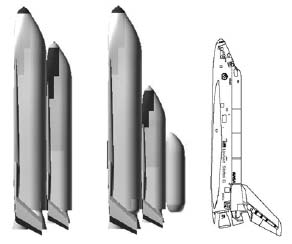
|
The one design requirement imposed on the study was the size of the payload being transported. For the internal payload bay, the payload was 15 ft in diameter by 30 ft in length—about half of the Space Shuttle orbiter’s payload bay. For the external cargo module, the internal cargo dimensions were 12 ft in diameter by 30 ft in length. This requirement enables the RLVs to transport payloads representative of those carried on medium-class ELVs and to accommodate the needs of passenger transport and logistics materiel transport, as discussed below.
Two design studies—one by the government and the other by industry—were performed. In the government design study, the payload weight and vehicle weights and sizes represented the unknown values and the values generated represented a closed system description. Two near-term RLV designs were generated using the assumptions and criteria described above (fig. 3). Both were capable of delivering a payload to a 100 nm circular orbit when launched east from Cape Canaveral, Florida. In both cases, the RLV was sized to return from orbit and land with the design payload weight enabling a payload to be retrieved from orbit and permitting payloads to be returned should deployment operations be prematurely terminated. The RLV sizing tools predict that a near-term RLV configuration with the internal payload carriage can deliver a 19,000 lb payload. The external carriage configuration RLV can deliver a 37,000 lb gross cargo module weight with a net cargo weight of 20,000-25,000 lb. or else a small reusable spaceplane, similar to the 1950s-era Dyna-Soar, in place of the cargo module. This crew-operated system, similar to that shown in Fig. 2, would be used for transporting 6-10 passengers to and from LEO.20 These near-term RLV concepts have an estimated gross weight of 2.3 million pounds.
Studies also assessed the suitability of using these conceptual sizing tools to represent configurations that industry should be able to develop and produce. AFRL contracted with a prime aerospace company to develop near-term TSTO RLV conceptual designs suitable for routine space access. The contractor was free to select the configuration, empty weight margins, etc. AFRL specified the approximate payload size and weight and the use of technologies consistent with a near-term design. The contractor provided several different configurations representing, in their view, near-term solutions. The configuration designed for the internal payload carriage had a 3.6 million pound gross weight and a 20,000 lb payload delivered to a 100 nm circular orbit east from Kennedy Space Center, Florida. The external payload carriage configuration delivered a gross cargo module weight of 35,000 lb and had a 3.5 million pound gross weight. These configurations used six RD-180-equivalent engines on the first stage and three RD-120-equivalent engines on the second stage. The contractor choose to use an average 22 percent empty weight margin applied to all subsystem weights including the propulsion subsystem. This equates to approximately 100,000 lb of unallocated empty weight incorporated in the closed design—about 3-5 times the payload weight—that would be used to accommodate first and second stage subsystem empty weight growth during development.21
To compare the government’s and contractor’s conceptual design tools, ASC/EN prepared an estimate of the empty weight of an RLV’s second stage using the contractor’s assumptions for empty weight margin, number of first stage and second stage engines, etc. This is referred to as a “match case” comparison and it helps to identify significant differences in weight estimation relationships and imbedded assumptions. The second stage empty weight reflects a good point for comparison because this is the weight that achieves orbit. The ASC/EN estimate of the second stage empty weight differed from the contractor’s estimate by less than one percent while individual subsystem-by-subsystem comparisons showed variances in the 5-10 percent range—typical of conceptual design methodologies.
The first conclusion to draw from these studies is that the government’s near-term RLV design methodology produces near-term RLV conceptual design results, subject to the input assumptions, comparable to those that would be provided by industry. The second conclusion is that the U.S. aerospace industry should be able to develop and produce reasonable near-term RLVs that offer, as the Air Force SAB noted, “great promise of enabling the future of military space operations and civil space activities.” Contrary to the expectations of some, RLVs should be seen as an option for meeting near-term routine spacelift capability needs. The interaction of this possibility with the recently updated U.S. Space Transportation Policy is discussed below.
Shuttle-Derived Super-Heavy Spacelifter
Growth in civil, commercial, and national security space operations would benefit from the ability to place large payloads into orbit. While the near-term RLVs described earlier would have the payload capacity to meet immediate passenger and routine cargo transport, establishing in-space logistics support operations to support extended space operations as well as providing the ability to launch large mission-specific payloads, such as those needed to support a renewed human exploration mission, would need a Saturn V-class super-heavy launch system.
A near-term solution for satisfying this spacelift need was first suggested nearly 30 years ago. It involves developing an unmanned cargo version of the Space Shuttle where the orbiter is replaced by the heavy or outsized payload. This option has been revisited several times since the 1970s, most recently in the updated U.S. Space Transportation Policy.22
The Shuttle-derived Super-Heavy Spacelifter is a version of this idea employing a vertically-stacked configuration with twin reusable fly-back boosters, an expendable central core, and the payload and payload fairing on top of the core (fig. 4). The reusable fly-back booster would be a variant of the first stage of a near-term RLV shown in Fig. 3. The maximum payload for an east launch would be approximately 160,000 lb. Oversize payloads up to 40 ft in diameter could be carried.
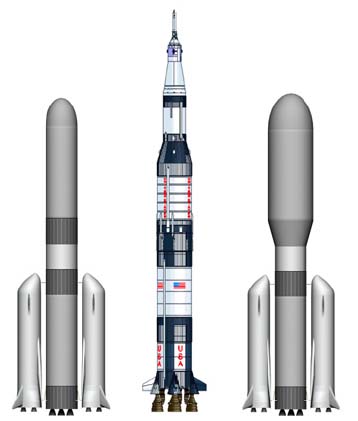 Figure 4. Normal and oversize payload versions of the Shuttle-derived Super-Heavy Spacelifter shown with the Saturn V |
Near-Term Concepts for
Extended Space Operations
The experience with the Hubble Space Telescope (HST) provides valuable lessons-learned in this regard. The HST’s remarkable history as a successful space science research instrument emphasizes two critical facts to be addressed when planning extended space operational capabilities that move beyond the current envelope of passive, fixed orbit, highly-redundant, software-fixable space operations. First, experience with the HST reinforces the fact that complex space systems are indeed subject to Murphy’s Law—what can go wrong might go wrong—and system design and support planning should reflect this fact. And second, human space operations support enables world-leading space operations that would not otherwise be possible.
In December, 2004, the National Research Council released recommendations regarding the use of the Space Shuttle for manned servicing of the HST in the 2007-2008 time period. The issue under review was whether, when Space Shuttles return to operation after the loss of the Columbia, a manned servicing mission was needed and could be undertaken at a lower risk than a robotic mission. The NRC committee concluded that “NASA should commit to a servicing mission to the Hubble Space Telescope,” that “NASA pursue a Shuttle servicing mission to HST,” and that “a robotic mission approach should be pursued solely to de-orbit the Hubble after the period of extended science operations enabled by a shuttle astronaut servicing mission, this allowing time for the appropriate development of the necessary robotic technology.”24 Dr. Robert P. Kirshner of Harvard University and President of the American Astronomical Society stated “The NRC formed a terrific panel of experts to weight the options and they concluded a manned servicing mission is the least risky way to extend Hubble’s life.”25
Certainly, robotic operations will play an important role in space, just as they are increasingly being used in terrestrial operations. Yet, whether in space or on the earth, the mastery that enables humans to design useful and successful robots requires first-hand knowledge, experience, curiosity, adaptability, and creativity that only experienced humans can provide. The National Research Council found “Previous human servicing missions to HST have successfully carried out unforeseen repairs as well as executing both planned and proactive equipment and science upgrades.” Further, “Space Shuttle crews, in conjunction with their ground-based mission control teams, have consistently developed innovative procedures and techniques to bring about desired mission success when encountering unplanned for or unexpected contingencies on-orbit.”26
One final note on the issue of human vs. robotic servicing for the HST. Initial estimates of the cost of this mission, prepared to support the NRC review, were in the range of $2B-$2.3B. The magnitude of these costs indicates that routine on-orbit space logistics capability to support expanded space operations would not be affordable using today’s limited logistics capabilities. Instead, an integrated space logistics architecture including transportation, on-orbit basing, servicing facilities, technician training, and standardized servicing methods, practices, interfaces, tools, and equipment would need to be deployed to significantly reduce the total cost of future HST-type repairs. How to achieve this integrated space logistics architecture/capabilities using near-term system solutions is addressed next.
Exploiting Near-Term
Reusable Spacelift Capabilities
The Department of Defense almost always has at least two design-independent military systems, e.g., multiple types of bombers, fighters, communication systems, etc., to perform or support critical national security missions. To enable growth in critical on-orbit military space operations, two design-independent RLV types, with comparable payload and performance, would be developed. This would provide assured space access to low Earth orbit (LEO) and prepare the industrial base for the expected follow-on second-generation RLV research and development efforts. This approach to providing assured space access is consistent with the assured space provisions of the recently updated U.S. Space Transportation Policy and reflected in the proposed FY06 federal budget which includes $340M to maintain assured space access capabilities using current ELVs.27
Five production flight systems of each type of RLV would be produced: three for operational use, one for testing, and one for major subsystem spares. Of the three operational flight systems, one would be in depot for phase inspections and subsystem upgrades, leaving two in flight status. With an IOC turnaround time of 30 days for each flight system, the combined fleets of the four RLVs in flight status would have the capacity to fly 48 missions per year—about one flight per week. At FOC, as operating experience and subsystem improvements reduce the inspection and maintenance requirements, the turnaround time for these fully-reusable systems may fall to, perhaps, 7 days. The combined fleets would have a capacity of 208 missions per year—about 4 flights per week. Current government ELV and Space Shuttle launches total approximately 20 per year. After meeting these routine spacelift needs, at FOC the combined near-term RLV fleet would have a remaining capacity for lifting, as an example, 2,000 tons of materiel and 280 passengers to orbit each year.28 Over a 20-year operational life of the near-term RLV fleet, the fleet could transport up to approximately 37,000 tons of material and 4,600 passengers while flying a total of approximately 3,400 missions. This capacity would be used to establish and sustain the initial on-orbit mobility and in-space logistics support capabilities, discussed below, as well as provide additional spacelift for new and expanding civil, commercial, and national security space operations. Note that this significant improvement in routine spacelift capacity comes from the use of near-term RLV designs with only a modest initial fleet size of six operational flight systems.
Reusable Space Logistics Vehicle
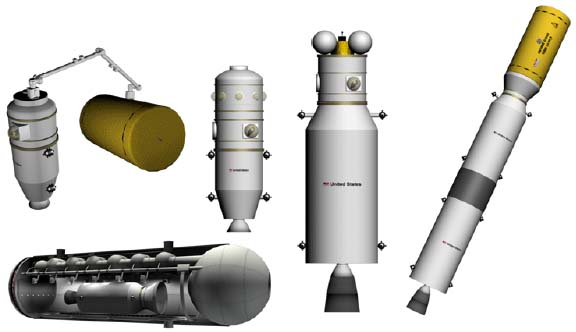 Figure 5. Conceptual “sketches” of Space Logistics Vehicle. From left to right: short-range crewed SLV tug holding a RLV cargo module; short-range crewed SLV with an additional passenger module; extended-performance, crewed SLV configured for satellite-refueling; two-stage, unmanned, extended-range SLV configured to deliver cargo to geostationary , lunar orbit, or Lagrangian points. The lower left illustration shows an extended range SLV inside a LEO space logistics base’s space hanger for maintenance. |
The initial SLVs would be configured as tugs, sized, with the crew module already attached, to fit within the RLV’s payload bay for transport to orbit. (This need established the initial estimate of the payload bay size requirement discussed previously.) The primary mission of the tug version of the SLV would be to transport cargo containers from a circular 100 nm orbit, where they would be dropped off by the RLVs, to the Space Logistics Base located in a higher 250 nm circular orbit. In the vicinity of the Space Logistics Base, the SLV tugs would move cargo containers and other materiel. With the addition of a separate passenger module, as seen in Fig. 5, the SLV tug would also transport personnel from the Space Logistics Base to co-orbiting facilities or spacecraft, such as the Space Logistics Transport discussed below.
Follow-on SLVs, also as shown in Fig. 5, would “grow” through the addition of larger propellant tanks and higher thrust engines to provide increased performance. These “extended performance” SLVs could undertake significant orbital altitude and inclination changes and then return to a LEO Space Logistics Base. With suitably-located LEO bases, these SLVs would enable servicing of satellites in geostationary orbit or other “high” orbits. Using a two-stage configuration, also shown in Fig. 5, they could deliver significant payload weight to geostationary or lunar orbit or the Earth-Moon Lagrangian points and then return to a space logistics base in LEO.29
To capitalize on the increased space access provided by near-term RLVs, the SLV tugs would be developed concurrently with the RLVs and deployed shortly after the RLVs achieve IOC. This requires that the SLVs also be based on designs that have their enabling technologies at TRL of 6 or greater. Initial conceptual design investigations indicate that all critical subsystem technologies for the SLV tug are currently in production for other space systems—propulsion, primary structure, thermal and micrometeoroid shielding, cryogenic propellant tanks, robotic arm, flight avionics, and crew support. For the extended-range SLV, the only new subsystem is a reusable rocket engine with a modest increase in thrust beneficial for missions to high Earth orbits, lunar orbit, and the Earth-Moon Lagrangian points. Such a high specific impulse, reusable rocket engine, incorporating AFRL propulsion technologies, is now entering prototype engine testing (TRL 6) with a prime engine contractor.30
LEO Space Logistics Bases
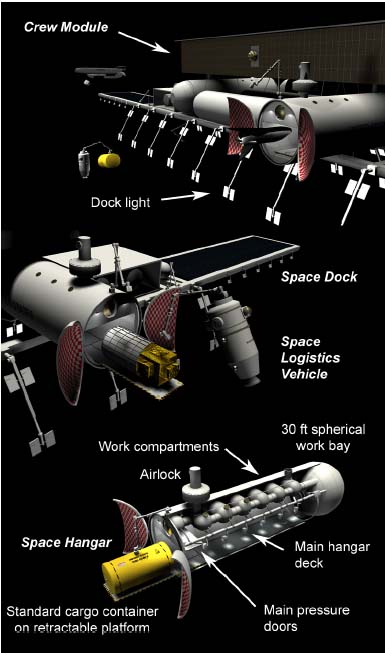 Figure 6. Notional Space Logistics Base consisting of twin, opposite-facing, space hangars, with an upper crew module and a lower space dock. In the top illustration, an SLV tug is maneuvering a cargo module while the second stage of a near-term RLV off-loads cargo. A passenger spaceplane is entering the nearest hangar. In the center illustration, an SLV tug positions a satellite at the entrance to the space hangar. The bottom illustration shows a cut-away view of the space hangar. |
The key to the near-term technological feasibility of these Space Logistics Bases, and other similar LEO facilities, is the ability to fabricate large and complex components on the Earth and launch them into orbit. This approach was initially demonstrated with the U.S. Skylab space station of the 1970s that used a single Saturn V rocket to launch the 3-person orbiting facility. In the integrated logistics architecture discussed in this paper, the Super-Heavy Spacelifter would provide a comparable launch capability.- Passenger and cargo terminal for transferring personnel and materiel to and from RLVs, co-orbiting facilities, and large spacecraft
- Quarters for assigned and visiting personnel
- Large space hangars to enable many servicing functions to be performed within a pressurized, shirt-sleeve work environment
- Materiel storage
- SLV base conducting inspection, repair, reconfiguration, replenishment and upgrades
- Space dock supporting the assembly of large spacecraft, orbiting facilities, and satellites
- Spacecraft base conducting inspection, repair, replenishment, and upgrades
A good example of the benefits that would arise from providing the ability to launch large components is the Space Logistics Base’s space hangar (fig. 6). Essentially, these space hangars perform the same function as an airport hangar. Both provide an environmentally-controlled environment enabling complex logistics operations on aerospace systems to be performed that would be difficult to accomplish “outside.” Terrestrial hangars—many designed for severe external structural load conditions due to hurricane winds or heavy snow loads—are assembled from prefabricated parts transported to the site. For the space hangar, the primary structural requirements are to safely contain the internal pressure loads when the hangar doors are shut and the hangar is pressurized for shirt-sleeve operations. By using the Super-Heavy Spacelifter, the outer pressure shell—in this example concept, 33 feet in diameter and about 130 feet in length—can be fully fabricated and structurally tested on the ground and then launched into orbit as a complete module. Interior work compartments, as shown in Fig. 6, would be transported to orbit using RLVs and then installed inside the hangar while it is pressurized. This mixture of terrestrial manufacturing and on-orbit assembly enables large pressurized structures to be built using near-term technologies.
One important advantage of providing large space hangars is that they would enable practical, routine on-orbit servicing. In this conceptual design, satellites and spacecraft up to approximately 15 feet in height, 25 feet in width, and 70 feet in length could be taken inside the hangar for servicing. With appropriate logistics-enabled designs—following the development and demonstration of standardized space servicing training, technologies, processes, tools, and equipment—servicing such future space systems should become comparable to similar support provided for terrestrial aerospace systems. This would complete an important step towards achieving mastery of space operations.
Up to three Space Logistics Bases would be needed to provide an initial level of on-orbit support. The first two bases would be located at an orbit inclination of approximately 30 degrees—corresponding to the expected latitude of the terrestrial RLV launch sites in Florida, for example. These bases would support the deployment and servicing of geostationary (GEO) satellites, using the extended performance SLVs, as well as support in-space research, development, test, and evaluation activities. These bases’ space docks would be used to assemble co-orbiting space facilities such as space hotels and specialized research laboratories. As described below, these docks could also support the assembly and basing of large crewed logistics spacecraft.
The third base would be located at an inclination of approximately 55 degrees. There it would support the deployment and servicing of satellites located in higher inclination orbits, e.g. GPS satellites, as well as satellites in polar orbits. This support base may be smaller in size and number of support personnel, however, consistent with reduced mission needs and the reduced RLV payload capabilities for supporting the higher inclination orbit.
Space Logistics Transport
The concept for a system to perform these logistics functions is the Space Logistics Transport (SLT). The design of large spacecraft, as compared to transatmospheric vehicles such as RLVs, is not driven by aerodynamic considerations associated with ascending to orbit or descending from orbit. This permits a more mission-driven configuration to be used that emphasizes the utilization of near-term technologies and systems, some of which could be adapted from other near-term space logistics systems.
The SLT, shown in Fig. 7, is a concept for a large, crewed spacecraft capable of performing spacelift and extended space operations capabilities throughout the Earth-GEO-Moon system. Essentially, the SLT is a mobile space hangar, as seen in the cut-away view in Fig. 7, with a flight deck attached to the top of the hangar for spacecraft command and control and a propulsion module attached to the rear of the hangar. The SLT can load cargo and passengers and “fly” to the necessary point in the Earth-GEO-Moon system to deliver passengers and cargo or conduct logistics servicing within its pressurized hangar.30 Upon mission completion it returns to its LEO Space Logistics Base.
To provide this expanded mobility, the SLT’s propulsion efficiency must be increased 15-20 percent over standard hydrogen-oxygen chemical rocket engines by using nuclear thermal rocket (NTR) engines. As the name implies, a NTR engine contains a nuclear fission reactor that uses thermal energy from nuclear fission to heat a working fluid such as hydrogen. The heated fluid is then expanded through a nozzle to produce thrust. Such engines were first tested in the 1960s, at thrust levels up to 250,000 lb, and are currently under development by U.S. industry for deep space exploration missions. In this conceptual design, the SLT uses oxygen-augmented NTR engines where oxygen is injected in the nozzle to combust with the heated hydrogen.32 This produces an afterburning effect that increases thrust while also achieving the needed 15-20 percent increase in the engine’s efficiency. With future upgrades to this propulsion system, perhaps incorporating a more advanced nuclear fusion propulsion engine, the SLT’s range of operations could be extended to cover the entire central solar system—including Mars and near-Earth asteroids and comets.
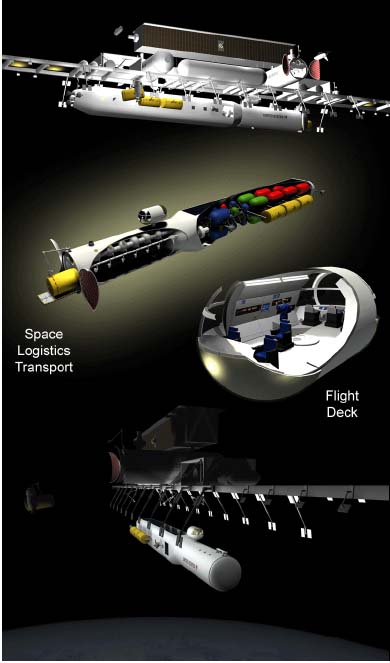 Figure 7. Notional Space Logistics Transport shown being resupplied at an orbiting Space Logistics Base and with a cut-away view showing the propellant tanks and cargo containers on the left and the space hangar on the right. A cut-away view of the flight deck is shown in the upper right. Prepared by Isiah Davenport and Dennis Stewart, General Dynamics, Advanced Information Systems. |
One final point. The large size of the SLT’s hangar also permits it to carry one or two SLV tugs to provide local passenger and cargo transport. From lunar orbit or the L1 Lagrangian point, a version of these tugs, configured for surface landing, could transport passengers and cargo to the lunar surface and back. This would enable scheduled transportation services to and from the Moon to support lunar exploration and possible future scientific and commercial operations.
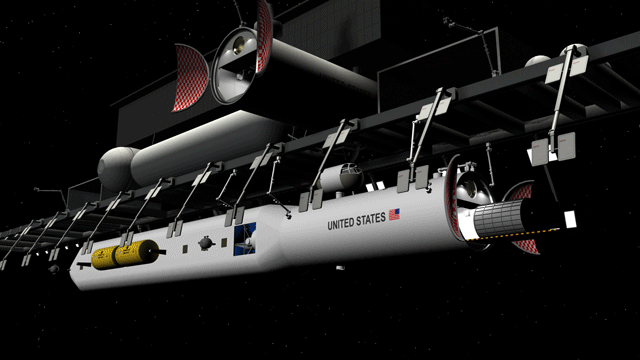 Figure 8. Animated illustration showing the assembly of the Space Logistics Transport at the LEO Space Logistics Base’s space dock. |
Is This Affordable?
Today, the federal government spends approximately $5 billion on spacelift providing approximately 10-20 flights per year, on average. At that rate, the federal government would spend about $100 billion on spacelift over the next 20 years. At the same time, the annual space GDP is about $95 billion per year with a payroll of about $24 billion per year.34 Over the next 20 years, the cumulative space GDP, without any growth, would be about $2 trillion. If the U.S. spent 2.5 percent of the space GDP on new space logistics infrastructure, this would add an additional $50 billion in new space logistics infrastructure. Thus, in today’s dollars, the government could be expected to spend approximately $150B on spacelift and extended space operations logistics capabilities over the next 20 years.
Of course, such infrastructure investment would likely increase the space GDP. A factor of two increase—perhaps on the low end with significant growth-enabling infrastructure additions—would add an additional $1 trillion to the national economy over the next 20 years. A factor of five increase—reflecting good growth commensurate with growth-enabling infrastructure investments—could add an additional $5 trillion to the economy or approximately 30 times an infrastructure investment of $150 billion. One may expect, as the space GDP grows, space logistics infrastructure investments would also grow, perhaps adding an additional $50-250 billion in space logistics infrastructure investment to maintain the historical average. This may fund, for example, the development of the follow-on reusable space access systems enhancing passenger travel to and from Earth orbit and the large crewed spacecraft.
Infrastructure building is generally not funded through annual appropriations, such as the Department of Defense budget, but through special funding mechanisms. One traditional method is to establish an “authority” responsible for the construction of the infrastructure and permitted to use government-backed bonds to raise the capital required to build the infrastructure. A combination of user fees and annual appropriations are then used to pay off the bonds over a period of 20-50 years once the infrastructure begins operations.
If, once the Space Shuttle ceases to operate in 2012, spacelift services would be taken over by the near-term RLVs discussed earlier, then the federal government could be expected to pay—using the same $5 billion per year as is currently spent of spacelift—about $100 billion, in today’s dollars, for replacement spacelift services. Preliminary estimates using conservative near-term RLV development, production, and operational cost estimates, lend confidence that this $100 billion in funding would be adequate to cover these costs as well as the interest cost on the bonds.35 In other words, it may indeed be possible to establish near-term RLV spacelift services to replace the Space Shuttle and ELVs without an increase in appropriated budget expenditures. Similar funding approaches would be used to pay for the development of the other space logistics concepts discussed in this paper, should their projected value support the needed investment.
Conclusion
Why is it important to understand these near-term possibilities? Because American history provides many successful examples of how building new logistics infrastructure to open new frontiers expands the economy and enhances national security while stimulating science and technology advancement, improving the industrial base, and creating enthusiasm in future workers. This highly successful strategy can be applied, over the next 20 years, to establish the mastery of space operations that will enable a significant expansion of human and robotics space operations and transform the United States into a true spacefaring nation.
Certainly, some will believe that the options discussed in this paper represent wishful, sci-fi thinking. However, recall that it was only 22 years from the breaking of the sound barrier in 1947 to the first lunar landing in 1969. This represented the accomplishments of the “doers,” then broadly populating the American aerospace industry. As the U.S. again turns its attention to planning its future in space, this “we can do it” attitude of the 1960s should be central to planning the accomplishments to be achieved in the first decades of the 21st century.
Notes
1. “USAF CONOPS Master Capability Library,” Version 5.4, http://www.dtic.mil/jointvision/ideas_concepts/afsaa_mcl.doc, p. 5.2. “USAF CONOPS Master Capability Library,” Version 5.4, http://www.dtic.mil/jointvision/ideas_concepts/afsaa_mcl.doc, p. 6.
3. Charles Henry Ambler, “A History of Transportation in the Ohio Valley,” Greenwood Press, 1931, pp. 67-68.
4. The growth in logistics infrastructure continued well into the 20th century with the building of an entirely new logistics infrastructure of local, state, and interstate paved roads brought about by the rapid growth of personal automotive transportation. This created an extensive associated travel infrastructure (i.e., automobile production, refueling stations, fuel production and distribution, vehicle repairs, travel lodging, food distribution and serving facilities, consumer product distribution and sales, and tourist attractions) that continues to logistically, technologically, and economically shape much of modern America. The aviation industry represents another 20th century example.
5. A survey of available river transport to support Union forces found approximately 250 passenger steamboats on the Ohio River and another 150 available in St. Louis, with the latter having a capacity for transporting 120,000 men. One hundred freight barges, with a capacity of 250,000 barrels, and 200 coal barges with a capacity of 2,000,000 bushels were also available on the Ohio River. The coal barges, in particular, were very important to sustaining Union forces. These commercial resources were readily available because Union and Confederate blockades of the Ohio and Mississippi Rivers, early in the war, virtually shutdown commercial river travel. U.S. War Department. War of Rebellion, Official Records (Washington, 1880-1901), Series I, Volume lii, Part I, pp. 164, as reported by Charles Henry Ambler, “A history of Transportation in the Ohio Valley,” Greenwood Press, 1931, pp 247-248.
6. Charles Henry Ambler, “A History of Transportation in the Ohio Valley,” Greenwood Press, 1931, p. 168.
7. Charles Henry Ambler, “A History of Transportation in the Ohio Valley,” Greenwood Press, 1931, pp. 181-184.
8. Arthur M. Squires, “The Tender Ship: Governmental Management of Technological Change,” Birkhäuser, 1986, p. 122.
9. U.S. Space Transportation Policy Fact Sheet, January 6, 2005, p. 1.
10. U.S. Space Transportation Policy Fact Sheet, January 6, 2005, p. 3.
11. Richard P. Hallion, “The Hypersonic Revolution,” Volume I, pp. 294-319.
12. Richard P. Hallion, “The Hypersonic Revolution,” Volume I, pp. 294-319.
13. Richard P. Hallion, “The Hypersonic Revolution: From Scramjet to the National Aero-Space Plane, Volume II, 1964-1986, pp. 1340.
14. Further discussion of the history of the AMSC, TAV, and NASP efforts is contained in 15 “The Hypersonic Revolution,” Vols. II and III.
15. “Why and Whither Hypersonics Research in the U.S. Air Force,” United States Air Force Scientific Advisory Board, SAB TR- 00-03, December 2000, p. 58.
16. The American Institute of Aeronautics and Astronautics (AIAA) Space Logistics Technical Committee addressed this issue at a panel session at the AIAA Space 2004 Conference in September, 2004. Representatives of several of the major aerospace airframe and rocket propulsion contractors expressed their belief that near-term, two-stage RLVs suitable for routine space access could be developed at this time.
17. Greg Moster, “Reusable Military launch System Team,” AFRL Tech Horizons, April, 2004.
18. Information on the RD-180 is available at http://www.astronautix.com/engines/rd180.htm. Information on the RD-120 is available at http://www.astronautix.com/engines/rd120.htm.
19. The SSME has been significantly improved since first flown in the early 1980s. These improvements have significantly increased its safety and reliability while also achieving modest improvements in total thrust.
20. When carrying the small spaceplane, the RLV does not return from orbit with the spaceplane. The spaceplane would return from orbit on its own.
21. The choice of an empty weight margin of approximately 22 percent compares with an approximate 25 percent weight growth in the Space Shuttle orbiter and reflected airframe designs that had not been previously flown. The government’s choice of a 15 percent empty weight margin applied to non-main propulsion empty weights was based on the use of airframe design characteristics similar to those of the Shuttle orbiter and the use of existing main rocket engines. The critical point in the program for the selection of the empty weight margin is at the completion of the preliminary design when vehicle size and manufacturing requirements begin to be established. Further and more detailed conceptual design analysis would help to select an empty weight margin appropriate to the specific design approach the contractor selects to build.
22. Fact Sheet, National Space Transportation Policy, 6 January 2005, http:// www.ostp.gov/html/SpaceTransFactSheetJan2005.pdf.
23. Final Report of the Commission to Assess United States National Security Space Management and Organization, pp. 21.
24. “Assessment of Options for Extending the Life of the Hubble Space Telescope: Final Report,” National Research Council, National Academies Press, Washington D.C., Prepublication Copy, December 2004, p. 7.
25. “American Astronomical Society Endorses National Research Council Report on ‘The Assessment of Options for Extending the Life of Hubble Space Telescope’,” January 19, 2005, http://yubanet.com/artman/publish/article_17220.shtml.
26. “Assessment of Options for Extending the Life of the Hubble Space Telescope: Final Report,” National Research Council, National Academies Press, Washington D.C., Prepublication Copy, December 2004, p. 6.
27. “DoD Doubles Launch Support, Boosts Overall Space Budget,” Defense News, 7 February 2005, p. 4.
28. This example is based on an annual FOC distribution of 160 flights each carrying 12.5 tons and 28 flights each carrying 10 passengers. These are in addition to the baseline 20 flights to meet current government launch needs.
29. Lagrangian point, http://en.wikipedia.org/wiki/Lagrange_point.
30. RL-60, http://www.pratt-whitney.com/prod_space_rl60.asp.
31. The total mission change in velocity or “Delta V” needed to undertake a LEO-lunar orbit-LEO mission is almost the same as that required to undertake a LEO-GEO-LEO mission. Hence, while the Moon is much farther from the Earth than is geostationary orbit, in terms of vehicle design requirements, these two missions are very similar. Both have requirements for approximately 30,000 feet per second of mission Delta V. This is also about the same Delta V required to conduct a mission to the Earth-Moon Lagrangian points.
32. Stanley K. Borowski and Leonard A. Dudzinski, “2001: A Space Odyssey Revisited—The Feasibility of 24 Hour Commuter flights to the Moon Using NTR Propulsion with LUNOX Afterburners,” NASA/TM—1998-208830/REV1, December 2001.
33. Data available from the Congressional Budget Office shows a range from 3.0 percent in 1960 to 2.5 percent in 1990.
34. “The Economic Impact of Commercial Space Transportation on the U.S. Economy: 2002 Results and Outlook for 2010,” Associate Administrator for Commercial Space Transportation, Federal Aviation Administration, March 2004, p.1.
35. Using the near-term RLV figurations described earlier in this paper and in ”Architecting Rapid Growth in Space Logistics Capabilities” (James M. Snead, AIAA 2004-4068, July 2004) the cost methodology of “Handbook of Cost Engineering for Space Transportation Systems (Revision 1) with Transcost 7.1 Statistical-Analytical model for Cost Estimation and Economical Optimization of launch Vehicles” (Dietrich E. Koelle, TCS – TransCostSystems, Liebigweb, Germany, February, 2003) yields an estimate of a development cost of approximately $25 billion for each flight system including passenger and cargo carriage capabilities. The Koelle methodology yields an estimate of the most likely program cost, including a 15-20 percent margin for cost growth. The Koelle production cost estimate for two systems was approximately $9 billion. The total development and production cost for two design-independent systems was approximately $60 billion. The recurring mission cost was estimated at $1,500 per pound x
25,000 lb = $38 million. (Recall that in 2000, the Air Force SAB anticipates lower costs in the range of $100-800 per pound, depending on launch frequency.) The recurring cost of flight operations for the 20 baseline government missions was estimated at $38 million x 20 mission per year x 20 years = approximately $15 billion. The combined total development, production, and operation cost is $75 billion compared with an available funding of $100 billion. The difference of $25 billion would pay most, if not all, of the interest costs on the $60 billion for RLV development and production.
|
|
James Michael Snead, P. E. (BSAE, University of Cincinnati; MSAE, Air Force Institute of Technology) is the lead for Agile Combat Support in the Aeronautical Systems Sector, Plans and Programs Directorate, Air Force Research Laboratory (AFRL), Wright-Patterson AFB, Ohio. He has also served as a science and technology engineer at AFRL, focusing on futures war gaming and future war-fighting concepts. Other positions at Wright-Patterson include lead structures engineer, Aeronautical Systems Center; chief flight-systems engineer/ lead structures engineer, National Aerospace Plane Joint Program Office; and project engineer, Transatmospheric Vehicle Project Office. Currently Mr. Snead is chairman of the American Institute of Aeronautics and Astronautics (AIAA) Space Logistics Technical Committee. |
Disclaimer
The conclusions and opinions expressed in this document are those of the author cultivated in the freedom of expression, academic environment of Air University. They do not reflect the official position of the U.S. Government, Department of Defense, the United States Air Force or the Air University.
